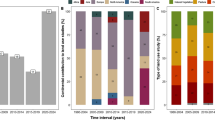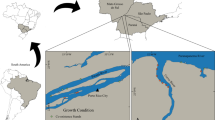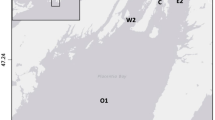Abstract
Modern biodiversity research focuses on multiple diversity facets because different indices may describe different ecological and environmental processes, as well as the effects of varied disturbances of natural and anthropogenic origins. We investigated littoral macroinvertebrate diversity in a large boreal lake system and specifically explored congruence of indices within and between the three diversity facets: species diversity, functional diversity and taxonomic distinctness. First, we found that the indices of taxonomic distinctness were the most sensitive indicators of eutrophication. Second, we observed that most correlations between the indices within the same diversity facet, and between the indices of functional and species diversity, were relatively strong. However, the indices of taxonomic distinctness (Δ+ and Λ+) were weakly associated with other metrics of diversity, emphasising the importance of taxonomic distinctness as a complementary dimension of biodiversity. Therefore, our observations support the importance to examine multiple facets for mapping biodiversity or for assessing the effects of anthropogenic disturbances on biological communities.
Article PDF
Similar content being viewed by others
Avoid common mistakes on your manuscript.
Abbreviations
- TP:
-
Total Phosphorus
- S:
-
Species richness
- J’:
-
evenness
- H’:
-
Shannon diversity
- Δ:
-
taxonomic diversity
- Δ+:
-
taxonomic distinctness
- Λ+:
-
variation in taxonomic distinctness
References
Abellán, P., Bilton, D.T., Millán, A., Sánchez-Fernández, D. and Ramsay, P.M. 2006. Can taxonomic distinctness assess anthropogenic impacts in inland waters? A case study from a Mediterranean river basin. Freshwater Biol. 51: 1744–1756.
Akaike, H. 1974. A new look at the statistical model identification. IEEE Transactions on Automatic Control 19: 716–723.
Bady, P., Dolédec, S., Fesl, C., Gayraud, S., Bacchi, M. and Schöll, F. 2005. Use of invertebrate traits for the biomonitoring of European large rivers: the effects of sampling effort on genus richness and functional diversity. Freshwater Biol. 50: 159–173.
Benke, A.C., Huryn, A.D., Smock, L.A. and Wallace, J.B. 1999. Length-mass relationships for freshwater macroinvertebrates in North America with particular reference to the southeastern United States. J. North Am. Benthol. Soc. 18: 308–343.
Bonada, N., Prat, N., Resh, V.H. and Statzner, B. 2006. Developments in aquatic insect biomonitoring: a comparative analysis of recent approaches. Annu. Rev. Entomol. 51: 495–523.
Chase, J.M. and Leibold, M.A. 2002. Spatial scale dictates the productivity-biodiversity relationship. Nature 416: 427–430.
Chase, J.M. and Ryberg, W.A. 2004. Connectivity, scale-dependence, and the productivity-diversity relationship. Ecol. Lett. 7: 676– 683.
Clarke, K.R. and Warwick, R.M. 1998. A taxonomic distinctness index and its statistical properties. J. Appl. Ecol. 35: 523–531.
Clarke, K.R. and Warwick, R.M. 2001. A further biodiversity index applicable to species lists: variation in taxonomic distinctness. Marine Ecology Progress Series 216: 265–278.
Clarke, K.R. and Gorley, R.N. 2006. Primer v6: User Manual/ Tutorial. Primer-E Ltd. 190 pp.
Devictor, V., Mouillot, D., Meynard, C., Jiquet, F., Thuiller, W. and Mouquet, N. 2010. Spatial mismatch and congruence between taxonomic, phylogenetic and functional diversity: the need for integrative conservation strategies in a changing world. Ecol. Lett. 13: 1030–1040.
Dodson, S.I., Arnott, S.E. and Cottingham, K.L. 2000. The relationship in lake communities between primary productivity and species richness. Ecology 81: 2662–2679.
Folt, C.L., Chen, C.Y., Moore, M.V. and Burnaford, J. 1999. Synergism and antagonism among multiple stressors. Limnol. Oceanogr. 44: 864–873.
Fore, L.S., Karr, J.R. and Wisseman, R.W. 1996. Assessing invertebrate responses to human activities: evaluating alternative approaches. J. North Am. Benthological Soc. 15: 212–231.
Friberg, N., Bonada, N., Bradley, D.C., Dunbar, M.J., Edwards, F.K., Grey, J., Hayes, R.B., Hildrew, A.G., Lamouroux, N., Trimmer, M. and Woodward, G. 2011. Biomonitoring of human impacts in freshwater ecosystems: the Good, the Bad and the Ugly. Adv. Ecol. Res. 44: 1–68.
Gallardo, B., Gascón, S., Quintana, X. and Comín, F.A. 2011. How to choose a biodiversity indicator - redundancy and complementarity of biodiversity metrics in a freshwater ecosystem. Ecol.Indic. 11: 1177–1184.
Gascón, S., Boix, D. and Sala, J. 2009. Are different biodiversity metrics related to the same factors? A case study from Mediterranean wetlands. Biol. Conserv. 142: 2602–2612.
Guerold, F., Boudot, J-P. Jacquemin, G., Vein, D., Merlet, D. and Rouiller, J. 2000. Macroinvertebrate community loss as a result of headwater stream acidification in the Vosges Mountains (N-E France). Biodivers. Conserv. 9: 767–783.
Heino, J. 2008. Patterns of functional biodiversity and function-environment relationships in lake macroinvertebrates. Limnol. Oceanogr. 53: 1446–1455.
Heino, J., Alahuhta, J. and Fattorini, S. 2015. Phylogenetic diversity of regional beetle faunas at high latitudes: patterns, drivers and chance along ecological gradients. Biodivers. Conserv. 24: 2751–2767.
Heino, J., Mykrä, H. and Kotanen, J. 2008. Weak relationships between landscape characteristics and multiple facets of stream macroinvertebrate biodiversity in a boreal drainage basin. Lands. Ecol. 23: 417–426.
Heino, J., Mykrä, H., Hämäläinen, H., Aroviita, J. and Muotka, T. 2007. Responses of taxonomic distinctness and species diversity indices to anthropogenic impacts and natural environmental gradients in stream macroinvertebrates. Freshwater Biol. 52: 1846–1861.
Jeppesen, E., Jensen, J.P., Søndergaard, M., Lauridsen, T. and Landkildehus, F. 2000. Trophic structure, species richness and biodiversity in Danish lakes: changes along a phosphorus gradient. Freshwater Biol. 45: 201–218.
Johnston, E.L. and Roberts, D.A. 2009. Contaminants reduce the richness and evenness of marine communities: a review and meta-analysis. Environ. Pollution 157: 1745–1752.
Kankaala, P., Hellsten S. and Alasaarela, E. 1984. Primary production of phytoplankton in the oligohumic Kitka lakes in northern Finland. Aqua Fennica 14: 65–78.
Klemm, D.J., Blocksom, K.A., Thoeny,W.T., Fulk, F.A., Herlihy, A.T., Kaufmann, P.R. and Cormier, S.M. 2002. Methods development and use of macroinvertebrates as indicators of ecological conditions for streams in the Mid-Atlantic Highlands Region. Environ. Monitor. Assess. 78: 169–212.
Korhonen, J.J., Wang J. and Soininen, J. 2011. Productivity-diversity relationships in lake plankton communities. PLos ONE 6: e22041.
Leira, M., Chen, G., Dalton, C. Irvine, K. and Taylor, D. 2009. Patterns in freshwater diatom taxonomic distinctness along an eutrophication gradient. Freshwater Biol. 54: 1–14.
Leonard, D.R.P., Clarke, K.R., Somerfield, P.J. and Warwick, R.M. 2006. The application of an indicator based on taxonomic distinctness for UK marine biodiversity assessment. J. Environ. Manage. 78: 52–62.
Litchman, E. and Klausmeier, C.A. 2008. Trait-based community ecology of phytoplankton. Ann. Rev. Ecol. Evol. Syst. 39: 615– 639.
Ludsin, S.A., Kershner, M.W., Blocksom, K.A., Knight, R.L. and Stein, R.A. 2001. Life after death in Lake Erie: nutrient controls drive fish species richness, rehabilitation. Ecol. Appl. 11: 731–746.
Lyashevska, O. and Farnsworth, K.D. 2012. How many dimensions of biodiversity do we need? Ecol. Indic. 18: 485–492.
Matthaei, C.D., Weller, F., Kelly, D.W. and Townsend, C.R. 2006. Impacts of fine sediment addition to tussock, pasture, dairy and deer farming streams in New Zealand. Freshwater Biol. 51: 2154–2172.
Mérigot, B., Bertrand, J.A., Gaertner, J-C., Durbec, J-P., Mazouni, N. and Manté, C. 2007. The multi-component structuration of the species diversity of groundfish assemblages of the east coast of Corsica (Mediterranean Sea): variation according to the bathymetric strata. Fish. Res. 88: 120–132.
Merritt, R.W. and Cummins, K.W. 1996. An introduction to the aquatic insects of North America. Kendall/Hunt Publishing Company. 862 pp.
Meyer, E. 1989. The relationship between body length parameters and dry mass in running water invertebrates. Archiv für. Hydrobiologie 117: 191–203.
Mittelbach, G.G., Steiner, C.F., Scheiner, S.M., Gross, K.L., Reynolds, H.L., Waide, R.B., Willig, M.R., Dodson, S.I. and Gough, L. 2001. What is the observed relationship between species richness and productivity? Ecology 82: 2381–2396.
Monnet, A-C., Jiguet, F., Meynard, C.N., Mouillot, D., Mouquet, N., Thuiller, W. and Devictor, V. 2014. Asynchrony of taxonomic, functional and phylogenetic diversity in birds. Global Ecol. Biogeogr. 23: 780–788.
Naeem, S., Duffy, J.E. and Zavaleta, E. 2012. The functions of biological diversity in an age of extinction. Science 336: 1401–1406.
Penning, W.E., Dudley, B., Mjelde, M., Hellsten, S., Hanganu, J., Kolada, A., van den Berg, M., Maemets, H., Poikane, S., Phillips, G., Willby, N. and Ecke, F. 2008. Using aquatic macrophyte community indices to define the ecological status of European lakes. Aquat. Ecol. 42: 253–264.
Pielou, E.C. 1966. Species-diversity and pattern-diversity in the study of ecological succession. J. Theoret. Biol. 10: 370–383.
Purschke, O., Schmid, B.C., Sykes, M.T., Poschlod, P., Michalski, S.G., Durka, W., Kühn, I., Winter, M. and Prentice, H.C. 2013. Contrasting changes in taxonomic, phylogenetic and functional diversity during a long-term succession: insights into assembly processes. J. Ecol. 101: 857–866.
Rasmussen, J.B. 1993. Patterns in the size structure of littoral zone macroinvertebrate communities. Can. J. Fish. Aquat. Sci. 50: 2192–2207.
Shannon, C.E. 1948. A mathematical theory of communication. The Bell System Technical J. 27: 379–423.
Smock, L.A. 1980. Relationships between body size and biomass of aquatic insects. Freshwater Biol. 10: 375–383.
Tachet, H., Richoux, B., Bournaud, M. and Usseglio-Polatera, P. 2010. Invertébrés d’eau douce. CNRS editions.
Tolonen, K.T., Vilmi, A., Karjalainen, S.M., Hellsten, S., Sutela, T. and Heino, J. 2017. Ignoring spatial effects results in inadequate models for variation in littoral macroinvertebrate diversity. Oikos. DOI: 10.1111/oik.03587
Van den Brink, P.J., A.C. Alexander, A.C., Desrosiers, M., Goedkoop, W., Goethals, P.L.M., Liess, M. and Dyer, S.D. 2011. Trait-based approaches in bioassessment and ecological risk assessment: strengths, weaknesses, opportunities and threats. Integrated Environ. Assess. Manage. 7: 198–208.
Vilmi, A., Karjalainen, S.M. Landeiro, V.L. and Heino, J. 2015. Freshwater diatoms as environmental indicators: evaluating the effects of eutrophication using species morphology and biological indices. Environ. Monitor. Assess. 187: 243–252.
Warwick, R.M. and Clarke, K.R. 1995. New ‘biodiversity’ measures reveal a decrease in taxonomic distinctness with increasing stress. Marine Ecology Progress Series 129: 301–305.
Warwick, R.M. and Clarke, K.R. 1998. Taxonomic distinctness and environmental assessment. J. Appl. Ecol. 35: 532–543.
Wilsey, B.J., Chalcraft, D.R., Bowles, C.M. and Willig, M.R. 2005. Relationships among indices suggest that richness is an incomplete surrogate for grassland biodiversity. Ecology 86: 1178– 1184.
Winter, M., Devictor V. and Schweiger, O. 2013. Phylogenetic diversity and nature conservation: where are we? Trends Ecol. Evol. 28: 199–204.
Witman, J.D., Cusson, M., Archambault, P., Pershing, A.J. and Mieszkowska, N. 2008. The relation between productivity and species diversity in temperate-arctic marine ecosystems. Ecology 89: S66–S80.
Author information
Authors and Affiliations
Corresponding author
Rights and permissions
This article is distributed under the terms of the Creative Commons Attribution 4.0 International License (http://creativecommons.org/licenses/by/4.0/), which permits unrestricted use, distribution, and reproduction in any medium, provided you give appropriate credit to the original author(s) and the source, provide a link to the Creative Commons license, and indicate if changes were made.
About this article
Cite this article
Tolonen, K.T., Vilmi, A., Karjalainen, S.M. et al. Do different facets of littoral macroinvertebrate diversity show congruent patterns in a large lake system?. COMMUNITY ECOLOGY 18, 109–116 (2017). https://doi.org/10.1556/168.2017.18.1.12
Received:
Revised:
Accepted:
Published:
Issue Date:
DOI: https://doi.org/10.1556/168.2017.18.1.12




